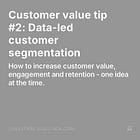Are you Doing Things Right or Doing the Right Things?
There is one thing that matters more than anything else

Get shit done.
Level up. Double down.
Find the sweet spot.
The business world is filled with buzz-words and phrases that sound pretty cool, but often lack substance and meaning.
When it comes to driving customer value, take a step back from the detail every now and then and reflect on what journey you are on and why?
I’m not referring to your roadmap of revenue initiatives, but rather the underlying rationale and reasoning behind your intended destination and route of travel.
The reason I raise this is because a common misperception is that the purpose of Customer Value is to maximise the benefit from the customers, whereas the intended meaning is for the customers.
Subtle difference in interpretation, big variation in what happens next.
This distinction is really important because if your primary goal is to make money, your chosen approach might not always make sense in the eyes of the customer. Therefore, it’s good practice to set out to make meaning, and the money will follow.
“Customer will create most value for you at the point he thinks you’re creating most value for him.”
— Don Peppers
If you find value in these free posts, give a try to the paid plan.

Balance is key
Now is a good time to reflect on the nature of your current business initiatives for the year ahead. Are they:
A list of revenue-making projects that adds up to one overall income target?
Customer experience and service improvements with barely no numbers attached?
Or perhaps something in between?
Consider the balance between your ‘Push’ and ‘Pull’ initiatives (i.e. Promotions vs Engagement). This works a bit like Yin and Yang from Chinese Daoist thought, where striking the right balance between these opposite, contrary forces achieves harmony.
Companies can easily fall into the trap where 100% of their initiatives come from one type of activity only, and you might have guessed already it’s typically from the first-mentioned category.
This is effective from a short-term financial perspective, but how many times can you possibly repeat the same campaigns and promotions? Once you need start thinking about which alternative remaining ways to maximize revenue through push-campaigns there are, this can lead you down the slippery slope of continuous price hikes whilst start watering down product/service offerings.
That is the road to nowhere.
It’s not about you, your business or your income targets. It’s about the customer.
“There is only one boss. The customer. And he can fire everybody in the company from the chairman on down, simply by spending his money somewhere else.”
— Sam Walton
This is a reader-supported publication. If you enjoy the content, let others know.
Be clear on what guides you
What is that ONE thing that matters more than anything else to succeed in driving customer value?
Here’s the twist. I can’t tell you exactly what it is — but your customers can. The answer to the riddle is that you must learn to engage with customers directly and listen to their needs, wants and feedback on the perceived value you are bringing.
This may like an obvious thing to do, but to add further context there are various challenges in this space you’ll want to be aware of.
Let me ask you a few questions around this:
- How do you currently measure Customer Value in your organisation?
- What does your process for collecting customer insight and feedback look like?
- How do you review and act on this information received?
- When did you last interact with a customer directly?
Take one minute to pause and reflect on the above before reading on
Many organisations have different measurement systems in place to gauge customer happiness and satisfaction, such as:
Customer Satisfaction Scores (CSAT) - e.g. “How happy were you with the service today?” (0-10, 0-100%)
Net Promoter Score (NPS) - e.g. “How likely are you to recommend us to a friend on a scale from 0-10.
All of these metrics have their place and purpose, but the main issue here is that there is no universal, standardised way of capturing and measuring customer value (but perhaps there should be — a future topic for a different post!)
There is a measurement issue here, but to enable us to move things forward, the next best action that we can take is to gather customer feedback in a systematic, rigorous and structured way.
Make sure you document everything in writing.
Here is a step-by-step approach that you can use get this activity underway:
- Ask the customers for feedback
- Log responses in writing
- Categorise the findings (data + verbiage)
- Analyze the results and look for patterns
- Evaluate and prioritize improvementsImplementing the above framework means that you’re ensuring that you have a much better chance of aligning your roadmap to perceived customer value.
Should you wish to dive deeper into the topic of today’s newsletter, you may also be interesting in exploring the following two articles.
If you found this post helpful, please tap the 💙 below
I always enjoy hearing from my readers. Please leave a comment subscribe or share this post!
Jens





Jens, your piece highlights an essential truth: customer value isn’t just a metric—it’s a philosophy. But here’s a perspective to take it even further: customer value doesn’t start with the customer—it starts with clarity about what your business uniquely brings to the table. The most successful companies understand their purpose so deeply that every interaction feels like an extension of that mission.
In one of my latest articles "Madiba’s Mountain", I reflected on building a life that honors what truly matters. The same principle applies to businesses: when you build with intention, rooted in authenticity, value flows naturally. It’s not just about listening to customers but about leading them, showing them something they didn’t know they needed while aligning with their deeper values.
You mention balancing "push" and "pull," which is critical, but what if we thought about “shared momentum”? Instead of campaigns that push or pull, create initiatives that align your business trajectory with your customer’s journey. It’s about co-creating value—helping customers succeed so deeply that their wins become your wins.
Customer value isn’t a project; it’s a partnership. The real question isn’t just what customers want today, but how your vision helps shape the value they’ll need tomorrow. Burn on! 🔥
I've never been a fan of CSAT and NPS - it's easier for the client, but you rarely get good answers that you can use to improve. I like your framework and have tried something similar, but it's still hard to stick with this approach as it requires a lot more time to prepare and follow up.
Do you see a way to simplify this?